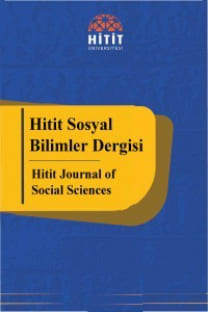TEKNİK ETKİNLİK ANALİZİNDE STOKASTİK SINIR YÖNTEMİ KULLANIMI ÜZERİNE BİR DEĞERLENDİRME
Etkinlik en geniş tanımıyla ideal seviyeye yaklaşma olarak tanımlanabilir. Ekonomiyi sayısallaştırırken kullanılan fonksiyonları dikkate alarak daha ayrıntıya girdiğimizde, etkinliği artık, fonksiyon olarak temsil edilebilen faaliyetlerde gözlenen değerlerin ideal değerlere yakınlık oranı olarak tanımlamak mümkün olur. Faaliyet olarak üretim faaliyetini ele aldığımızda etkinliğin iktisat içindeki günümüze kadar olan gelişimi ile yüz yüze geliriz. Etkinliği teknik etkinlik ile ekonomik veya tahsis etkinliği ayrımında ele almak mümkündür. Tahsis etkinliği, kaynak kullanımındaki etkinlik aracılığıyla ekonomi tanımının özüne atıf yapmasına karşın uygulamaya yatkın değilken, teknik etkinlik bu ayrımda fonksiyonel hesaplamaya yakınlığıyla uygulamalarda öne çıkmaktadır. Teknik etkinlik bu pratik özellikleriyle performans ölçümlerine yönelik kullanımlara bir altyapı sağlamaktadır. Teknik etkinlik tanımında kullanılan sınır fonksiyonun aynı zamanda üretim sınırını ima etmesi, stokastik sınır yöntemi için de çıkış noktasını oluşturur. Çalışmamızda, stokastik sınır yönteminin anlaşılmasını sağlamak için bu kavramsal ilişkiler incelenerek tespit edilen önemlinoktalar tartışılmaktadır. Yöntemin öne çıkan özellikleri tanıtılmakla birlikte gelecekteki uygulamaları için çağrıda bulunulmakta; bunun yanında handikap oluşturabilecek özellikleride araştırılmaktadır.
Anahtar Kelimeler:
Etkinlik, Teknik Etkinlik, Stokastik Sınır Yöntemi, Sınır Fonksiyonu
___
- AFRIAT, S.N. (1972), “Efficiency estimation of production functions”, International Economic Review,13, 568-598
- AIGNER, D.J. ve Chu S. (1968), “On Estimating the Industry Production Function”, American Economic Review, 58: 826-835.
- AIGNER, D.J., Lovell, C.A.K. ve Schmidt, P. (1977), “Formulation and Estimation of Stochastic Frontier Production Function Models”, Journal of Econometrics, 6, 21-37.
- BATTESE, G.E. ve Coelli, T.J. (1988), “Prediction of Firm-Level Technical Efficiencies With a Generalised Frontier Production Function and Panel Data”, Journal of Econometrics, 38, 387-399.
- BATTESE, G.E. ve Coelli, T.J. (1991), “Frontier Production Functions, Technical Efficiency And Panel Data: With Application To Paddy Farmers In Indiaa”. Working Papers in Econometrics and Applied Statistics. No.56, Department of Econometrics, University of New England, Armidale.
- BATTESE, G.E. ve Coelli, T.J. (1992), “Frontier Production Functions, Technical Efficiency and Panel Data: With Application to Paddy Farmers in India”, Journal of Productivity Analysis, 3, 153-169.
- BATTESE, G.E. ve Coelli, T.J. (1995), “A Model for Technical Inefficiency Effects in a Stochastic Frontier Production Function for Panel Data”,Empirical Economics, 20, 325-332.
- BATTESE, G.E. ve Corra, G.S. (1977), “Estimation of a Production Frontier Model: With Application to the Pastoral Zone of Eastern Australia”, Australian Journal of Agricultural Economics, 21, 169-179. BAUER, P.W. (1990), “Recent Developments in the Econometric Estimation of Frontiers”, Journal of Econometrics, 46, 39-56.
- BERG, S.A., Forsund, F.R, Hjalmarsson, L. ve Suominen, M. (1993), “Banking Efficiency in the Nordic Countries”. Journal of Banking & Finance.(17) 2-3, 371–388.
- COELLI, T.J., Perelman, S. ve Romano, E. (1999), “Accounting for environmental influences in stochastic frontier models: With application to international airlines”, Journal of Productivity Analysis, 11, 251-273.
- CORNWELL, C., Schmidt, P. ve Sickles, R.C. (1990), “Production Frontiers with CrossSectional and Time-Series Variation in Efficiency Levels”, Journal of Econometrics, vol. 46, 185-200.
- DAS, A., A. Nag, ve S.C. Ray (2009), “Labor-use Efficiency in Indian Banking: A Branch-level Analysis”. Omega, 37 (2009) 411-425.
- FÄRE, R. ve Lovell, C.A. (1978), “Measuring the Technical Efficiency of Production”, Journal of Economic Theory, 19, 150-162.
- FARREL, M. (1957), “The Measurement of Productive Efficiency”, Journal of the Royal Statistical Society, A120: 253-81
- FRIED, H.O. , Lovell, C.A.K. ve Schmidt, P. (eds.), (1993), The Measurement of Productive Efficiency: Techniques and Applications, Oxford University Press, Oxford.
- GOOD, D.H., Nadiri, M.I. ve Sickles, R.C. (1991), “The structure of production, technical change and efficiency in a mutinational industry: An application to U.S. airlines”, National Bureau of Economic Research, NBER Workin Paper No:3939.
- HUGHES, M.D. (1988), “A Stochastic Frontier Cost Function for Residential Child Care Provision”, Journal of Applied Econometrics, 3, 203-214.
- JONDROW, J., Lovell, C.A.K., Materov, I.S. ve Schmidt, P. (1982), “On estimation of Technical Inefficiency in the Stochastic Frontier Production Function Model”, Journal of Econometrics, 19, 233-238.
- KENNEDY, P. (2008), A Guide to Econometrics, 6th edition. Blackwell, Massachusets.
- KUMBHAKAR, S.C. (1987), “Production Frontiers, Panel Data: An Application of U.S. Class 1 Railroad”, Journal of Business and Economic Statistics, 5 (2): 249-255.
- KUMBHAKAR, S.C. (1990), “Production frontiers, panel data and time-varying technical inefficiency”, Journal of Econometricsl, 46:1/2 (October /November), 201-12.
- LEE, R.D. (2012), “Economic Efficiency”. FEE-Foundation for Economical Education. http://www.fee.org/the_freeman/detail/economic-efficiency/#axzz2F1VAFZw1. Erişim tarihi: 13/08/2012.
- MARIN, P.L. (1995), “Productivity differences in the airline industury: Partial deregulation versus short-run protection”, JEL Discussion Paper, No.EI/11, JEL Nos.:D24,L59,L23,L93.
- MULATU, A. ve Crafts, N.F.R. (2005), “Efficiency among Private Railway Companies in a weakly Regulated System: The Case of Britain's Railways in 1893-1912”, Working Paper No: 08/05, Department of Economic History, London School of Economics (http://www.lse.ac.uk/collection/ economichistory/).
- RAY, S.C. ve Mukherje, K. (1996), “Decomposition of the Fisher ideal index of productivity: A non-parametric dual analysis of US Airlines Data, The Economic Journal, vol.106, no.439, 1659-1678.
- RICHMOND, J. (1974), “Estimating the efficiency of production”, International Economic Rewiev, 15, 515-521.
- SCHMIDT, P. (1976), “On the Statistical Estimation of Parametric Frontier Production Functions”, The Rewiev of Economics and Statistics, vol.58, issue 2, 238-239.
- SCHMIDT, P. ve Sickles R.C. (1984), “Production Frontiers and Panel Data”, Journal of Business & Economic Statistics, vol. 2, No. 4, 367-374.
- SICKLES, R.C. (1985), “A nonlinear multivariate error components analysis of technology and specific factor productivity growth with an application to the U.S. airlines”, Journal of Econometrics, 27, 61-78.
- SICKLES, R.C.,Good, D. ve Johnson, R.L. (1986), “Allocative distortions and the regulatory transition of the U.S. airline industry”, Journal of Econometrics, 33, 143-163.
- TIMMER, C. (1971), “Using a Probabilistic Frontier Production Function to Measure Technical Efficiency”, Journal Of Political Economy, 79: 776-794
- WEINSTEIN, M.A. (1964), “The sum of values from a normal and truncated normal distrubution”, Technometrics, 6, 104-105 and 469-470.
- Yayın Aralığı: Yılda 2 Sayı
- Başlangıç: 2008
- Yayıncı: Hitit Üniversitesi
Sayıdaki Diğer Makaleler
ULUS DEVLETSİZ DEVLET SİSTEMİ: LÜBNAN MODELİ
HALK BİLGİSİ YÖNÜYLE FAKİR BAYKURT ROMANLARI
TÜRK MEDYASININ SERMAYE YAPISI VE SİYASAL İKTİDARLA İLİŞKİSİ ÜZERİNE BİR İNCELEME
TEKNİK ETKİNLİK ANALİZİNDE STOKASTİK SINIR YÖNTEMİ KULLANIMI ÜZERİNE BİR DEĞERLENDİRME
ÖZ DEĞERLENDİRMENİN 360 DERECE GERİ BESLEME YÖNTEMİNDEKİ İŞLEVSELLİĞİ
